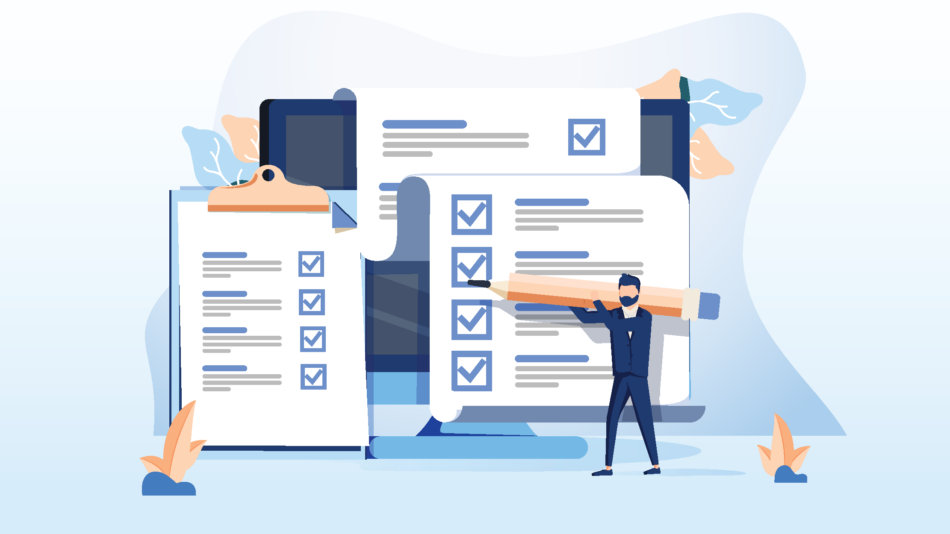Small Businesses (businesses with less than 500 employees) represent the overwhelming majority (over 99%) of all U.S. Businesses. While small businesses are common, long-term success is far from typical, with 20% failing within their first year and around 50% failing to make it past five years. Many of the reasons why new businesses fail comes down to a lack of planning and preparedness. Ensure that you start your business on the right foot by following this step-by-step guide on how to start a business.
Steps to Starting a Business:
- Research your Idea and Market
- Write a Business Plan
- Choose a Business Structure
- Pick and Register your Business Name
- Obtain an EIN
- Complete State Tax Registrations
- Apply for Licenses and Permits
- Open a Business Bank Account
- Setup Credit Card Processing
- Establish an Accounting System
- Get Business Insurance
- Hire Employees and Setup Payroll
- Market and Grow your Business

1. Research your Idea and Market
The first step towards starting your own small business is what kind of business you will operate. Most people who are serious about starting a business have the basic idea of their business down but fail to do adequate research before getting started.
You want to understand the audience your product or service will have and, more importantly, how to sell to them. You’ll also want to understand what your prospective competitors are doing to identify weaknesses in their strategy and what works. You can often find lucrative opportunities by finding areas within the market that are underserved or not served at all.
2. Write a Business Plan
Once you have completed your research, it’s time to take the next step into making your business a reality by creating a written business plan. Your business plan will provide a general roadmap for your business and answer some essential questions such as:
- What need(s) are you addressing
- What will make your business different
- Who is the target audience
- How will your business make money
- How will you promote your business
- What do you need to get started
3. Choose a Business Structure
One of the most important decisions you will need to make is the business structure you will operate your business as. A business’s legal structure will impact a wide variety of things such as taxes and personal liability risk if you are sued. You should choose your business structure before most other necessary filings, such as registering your business with the state, obtaining a DBA name, obtaining Tax ID numbers, and filing for licenses and permits.
When making your choice, you should choose a business structure that will give you the right balance of legal protections and benefits that work best for your situation. If you are unsure which entity is the right choice for you, read our choosing your business structure guide for more details. Below are brief descriptions of the most popular business structures.
Limited Liability Company (LLC)
The limited liability company (LLC) has become one of the most preferred business structures. They allow a blend of personal asset protection similar to a corporation with a Sole Proprietorship or Partnership’s pass-through tax flexibility. LLCs protect their owners from personal liability in most circumstances so that your personal assets won’t be at risk if your business is sued or files for bankruptcy.
Learn More about LLCs
Corporations
Corporations also referred to as a C-Corp, are a type of formal legal entity recognized as a separate entity from their owners. The owners of a corporation are referred to as shareholders and are issued stock according to their ownership interest. Corporations offer more robust protection to their owners from personal liability than other entity types. However, the cost to form a Corporation is higher and requires more detailed recording keeping. Corporations are also subject to double taxation as their profits are taxed before being distributed to shareholders.
Learn More about Corporations
S-Corporations
S-Corporations also referred to as an S-Corp, is a specialized type of corporation that allows a business to avoid the largest drawback to C-Corps of double taxation. S-Corps permit their owners to pass profits and some losses to their personal income without being subject to Corporate tax rates. S-Corps must file form 2553 with the IRS to obtain S-Corp tax status. Also, be mindful that S-Corporations are limited to no more than 100 shareholders. Not all states treat S-Corps the same, so you should ensure that they are recognized within your state.
Learn More about S-Corps
Sole Proprietorship
Sole Proprietorships are the simplest type of business structure. If you start conducting business activities as an individual without formal registration, you are a Sole Proprietor by default. As the sole owner, you are entitled to all profits and responsible for all business debts, losses, and liabilities.
Learn More about Sole Proprietorships
Partnership
Partnerships are the simplest type of business structure with two or more owners. There are three types of Partnerships:
- General Partnership: An unincorporated business with two or more owners. Each partner has unlimited personal liability for debts and obligations for the company. Profits and losses are passed through to the owner’s personal tax returns.
- Limited Partnerships (LP): A business where one general partner has unlimited liability and all other partners have limited liability. Partners with limited liability tend to have less or limited control over the business.
- Limited Liability Partnerships (LLP): All partners are given limited liability, protecting each other from debts of the partnership and meaning that they will not be responsible for other partners’ actions.
Learn More about Partnerships
4. Pick and Register your Business Name
Once you have determined your business structure, you will need to name your business. Naming your business is one of the most critical initial steps. Choosing the right business name will have many long-lasting impacts, such as the growth and perception customers have of your business. It’s important to remember that your business name and brand are the first things that customers interact with, so it can be a make or break item for new businesses.
Additional Information about Business Names:
5. Obtain an EIN
Once you have taken steps to form your business legally and register your business name, you will want to obtain an EIN. An EIN, also known as Employer Identification Number (EIN), Federal Tax ID, or FEIN, is a unique ID number issued by the IRS that is required for most businesses to pay taxes, open a business bank and apply for business licenses and permits. Learn more about how EINs are used, who must register for one, and how to apply for an EIN.
6. Complete State Tax Registrations
You will also need to complete state tax registrations to ensure you comply with state law. The state-level tax registrations you will need to complete will vary depending on the state where your business will operate and the specific type of business you will operate. The most common type of state-level registrations are for a seller’s permit (to remit sales and use tax) and a state withholding tax or employer ID if you will have employees.
Learn More about State Tax Registrations
7. Apply for Licenses and Permits
An essential segment in the steps to starting a business will be maintaining legal compliance by obtaining all your required licenses and permits. Business licenses and permits are issued by federal, state, county, and local government agencies—over 74,000 different governmental bodies in the U.S. issue business licenses and permits. The required licenses and permits that your business will need will depend on the type of business and your location. Certain kinds of trades will require additional professional licenses.
8. Open a Business Bank Account
Establishing a business bank account is an essential step to establishing your business as more than a hobby. Opening a business bank account is required to remain compliant from a legal and tax perspective if you form your business as an LLC or Corporation. If you don’t have separate business bank and credit accounts, you can put your business at risk in the event of being sued. Opening a business bank account will also help when it comes time to prepare and file your business taxes.
9. Setup Credit Card Processing
In the modern business world, accepting credit card payments has become almost essential. Credit and debit cards now represent over 60% of payments. So if you want to be competitive and maximize your revenue potential and customer base, you need to accept credit card and debit card payments. In our guide to accepting credit card payments you’ll learn about:
- How Credit Card Processing Works
- Types of Credit Card Processors
- How to Choose a Credit Card Processing Provider
- Credit Card Processors by Business Need
10. Establish an Accounting System
It’s essential to set up an accounting system that will allow you to keep your business running smoothly and provide financial insight into how your business is performing. Establishing an accounting system will allow you to create and manage a budget, manage cash flow, generate financial statements like profit and loss statements and balance sheets, and file your taxes. Most importantly, having an accounting system will make sure you make smart business decisions to ensure you are getting the best return on investment (ROI). In our small business accounting 101 guide you’ll learn:
- What Small Business Accounting Is
- How to do Accounting for a Small Business
- How to Keep Books for a Small Business
11. Get Business Insurance
An often-neglected area of importance for new businesses is getting business insurance. Business insurance can help mitigate your business’s risks to focus on establishing and growing your business. Without business insurance, you could be leaving yourself at significant risk in events such as accidents, natural disasters, and lawsuits. In our small business insurance guide, we go over:
- What types of insurance you should consider
- What small business insurance covers
- The 6 types of business insurance
12. Hire Employees and Setup a Payroll
Unless you want to shoulder the entirety of your business’s work, you want to build a team of great people to make your business successful. Even if you don’t plan to start with employees, you’ll want to make sure you plan on when and how you will build your team and hire your first employees.
Additional Information Related to Hiring:
13. Market and Grow your business
Launching your business getting your first sales can be an exceedingly difficult task and one that you will need a well-thought-out plan to achieve. Having a well-defined marketing plan is essential to get started and grow your business. Learn about the basics such as creating a unique selling proposition (USP), creating a marketing plan, making your first website, and launching your first marketing & advertising campaign.
State Specific Guides on Starting a Business
If you are looking for guides that are more specific to starting a business in your state, click on your state in the list below:
- Alabama
- Alaska
- Arizona
- Arkansas
- California
- Colorado
- Connecticut
- Delaware
- Florida
- Georgia
- Hawaii
- Idaho
- Illinois
- Indiana
- Iowa
- Kansas
- Kentucky
- Louisiana
- Maine
- Maryland
- Massachusetts
- Michigan
- Minnesota
- Mississippi
- Missouri
- Montana
- Nebraska
- Nevada
- New Hampshire
- New Jersey
- New Mexico
- New York
- North Carolina
- North Dakota
- Ohio
- Oklahoma
- Oregon
- Pennsylvania
- Rhode Island
- South Carolina
- South Dakota
- Tennessee
- Texas
- Utah
- Vermont
- Virginia
- Washington
- West Virginia
- Wisconsin
- Wyoming

